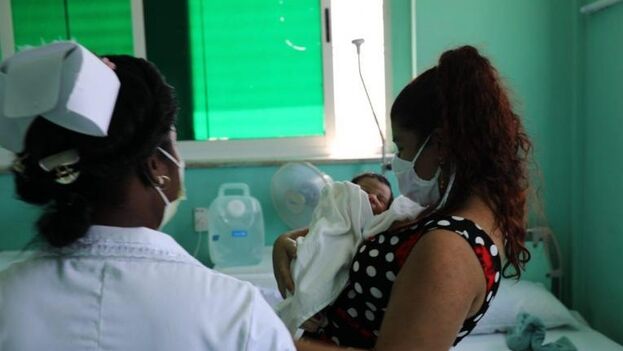
![]() 14ymedio, Madrid, 2 January 2022 –The infant mortality rate fails to recover in Cuba and barely fell by a tenth compared to last year, when some of the worst data in recent decades were recorded, with 7.6 deaths per thousand live births. This year, the rate remains at 7.5, more than two and a half points above the 2020 figure, which was 4.9.
14ymedio, Madrid, 2 January 2022 –The infant mortality rate fails to recover in Cuba and barely fell by a tenth compared to last year, when some of the worst data in recent decades were recorded, with 7.6 deaths per thousand live births. This year, the rate remains at 7.5, more than two and a half points above the 2020 figure, which was 4.9.
Although the Island continues to have positive indicators in the regional context, it is increasingly moving away from the positions of the rich countries with which it liked to compare itself, being at a good distance from the rates of 2 or 3 per thousand in most of Europe.
The data have been released on Monday and leave some Cuban provinces with disheartening numbers. The worst was Mayabeque with 12.2, followed by Santiago de Cuba (9.9), Guantánamo (9.7), Havana (9.5) and Camagüey (9.1). In the middle area there are Villa Clara (7.3), Las Tunas (7), Granma (6.6) and Ciego de Ávila (6.2). The best data are in Cienfuegos (4.3), Holguín (4,5), Sancti Spíritus (4.7), Matanzas (5), Artemisa (5.4) and Pinar del Río (5.9). Isla de la Juventud, the province with the lowest number of births (in 2021 there were 789, compared to 3,542 in Ciego de Ávila, the next with the lowest fertility), is 2.6.
The improvement can be seen, on the other hand, in the maternal mortality data, which last year were devastating. In 2021, 175 pregnant women died, leaving the rate at an alarming 176.6 per 100,000 live births. The increase was alarming compared to the previous year, when 40 died, leaving a percentage increase of 34.5%. This year, on the other hand, it has dropped to 39, a total of 40.9 per 100,000 live births.
According to data from the Ministry of Public Health, the incidence of COVID-19 has also decreased significantly since vaccination with Abdala began on July 29, 2021. The last death of a pregnant woman with COVID occurred in October 2021, and 9,874 infections were detected. The authorities attributed the bad maternal mortality data to COVID-19 last year, and the recovery could be attributed to the same.
There are few official responses, on the other hand, to analyzing the infant mortality data, which barely moves, although from the outside it has been stated on several occasions that the neglect of the Maternal and Childcare Programs (Pami) is the most plausible cause. The project has less funds, like almost everything on the Island, and the professionals are fewer and fewer each day, since the abandonment of the profession is massive, in some cases to leave the country and in others to dedicate oneself to another more lucrative sector, less overloaded with work and demands.
Noemí Causa Palma, national head of Pami, said, according to the official report, that “measures have been implemented for the improvement of the doctor and family nursing program and the elaboration of the development plan for the specialties of Obstetrics and Gynecology, Neonatology, Pediatrics, Pediatric Intensive Care, Pediatric Surgery and Comprehensive General Medicine,” although it doesn’t seem that these efforts to improve the situation have contributed much.
Another indicator that barely moves is that of adolescent pregnancies, which went from 18% in 2021 to 17.8% in 2022, a small shift if one takes into account that campaigns have been carried out to put an end to this problem.
The only data that give the Ministry of Public Health a respite are those of infant mortality due to congenital defects. The rate is 0.96 per thousand live births and goes from being the second to the fourth cause of deaths in children under one year of age. Ultrasound screenings are high, with responses exceeding 90%, reaching 99% in second and third trimester ultrasounds.
After all these data, there is another one that continues to highlight the demographic debacle of the Island. In 2022, 95,402 Cubans were born, 3,694 fewer than the previous year. The decline is a logical consequence of the massive Cuban emigration, which occurs especially among young people, and the aging of the population remains unstoppable. Although the census carried out in the year that has just ended has not yet been revealed, catastrophic numbers are expected.
Finally, the note reviews the assisted reproduction program. In 2022, 15,679 infertile couples were evaluated, little more than last year; however only 5,912 pregnancies were obtained, compared to 6,199 the previous year. “This decrease is due to the fact that high-tech pregnancies were not achieved in territorial centers, a result that was achieved in 2021 with the development of 316.” On the other hand, in the provincial services the data were better and went from 1,819 pregnancies the previous year to 2,113 in 2022.
“The instability of some medicines influenced the decrease in pregnancies conceived since municipal consultations, where 3,799 were conceived against 3,998 in 2021,” the note adds.
Translated by Regina Anavy
____________
COLLABORATE WITH OUR WORK: The 14ymedio team is committed to practicing serious journalism that reflects Cuba’s reality in all its depth. Thank you for joining us on this long journey. We invite you to continue supporting us by becoming a member of 14ymedio now. Together we can continue transforming journalism in Cuba.
